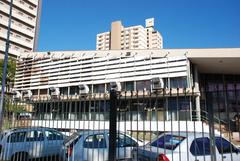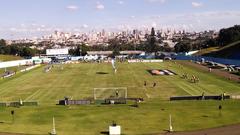Terminal Rodoviário de Londrina: Visiting Hours, Tickets, and Complete Travel Guide
Date: 04/07/2025
Introduction
The Terminal Rodoviário de Londrina is a central hub for transportation and a significant cultural landmark in Londrina, Paraná, Brazil. Known for its modernist architecture and dynamic role in urban development, the terminal not only facilitates regional, interstate, and international travel, but also stands as a testament to Londrina’s historical growth and architectural ambition. This guide offers detailed information on visiting hours, ticketing, accessibility, and nearby attractions, ensuring visitors can make the most of their experience at one of Paraná’s most important transport and cultural sites (The Brasilians, ArchDaily).
Table of Contents
- Historical Background
- Architectural Significance
- Evolution and Adaptive Reuse
- Visitor Information
- Urban and Cultural Impact
- Frequently Asked Questions (FAQ)
- Practical Information
- Visuals and Media
- Conclusion and Resources
Historical Background
Founded in 1930, Londrina’s rapid development was catalyzed by its diverse immigrant communities and thriving coffee economy. With this expansion, the need for a modern transportation hub arose. The original bus terminal, designed by João Batista Vilanova Artigas and completed in 1952, became Paraná’s first modernist architectural landmark. Its innovative concrete shell and open-plan layout were integrated with Praça Rocha Pombo, setting a precedent for public architecture in the state (The Brasilians, Google Arts & Culture).
By 1988, increasing demand led to the construction of a new terminal, designed by Oscar Niemeyer. Its circular structure, central skylit garden, and functional layout reflect the signature principles of Brazilian modernism (blog.londrina.pr.gov.br, cidadedelondrina.com.br).
Architectural Significance
The Original Terminal: Vilanova Artigas
- Design Features: A longitudinal, trapezoidal concrete block with open floors, ramps, and staircases for fluid circulation.
- Structural Innovation: A lightweight concrete shell (12 cm thick) and expansive glass panes maximize light and accessibility.
- Urban Integration: Seamlessly connects with Praça Rocha Pombo, demonstrating architectural harmony with the city’s public realm (ArchDaily).
The New Terminal: Oscar Niemeyer
- Layout: Circular plan with a central garden illuminated by a skylight, surrounded by ticket counters and platforms.
- Materials: Reinforced concrete enables broad curves and open spans, with a central oculus symbolizing movement and openness.
- Capacity: 57,615.80 m², 55 platforms, serving about 6,000 passengers daily (DeÔnibus, cidadedelondrina.com.br).
- Commercial Spaces: Over 30 retail areas and a food court (as of 2024, about 10 in operation).
Evolution and Adaptive Reuse
After decades as Londrina’s main bus station, the original terminal was repurposed in 1993 as the Museu de Arte de Londrina, preserving its architectural heritage and providing a venue for exhibitions and cultural activities (The Brasilians). The new terminal, meanwhile, continues to serve as a major transport hub, embodying the city’s commitment to modernism and functional design.
Visitor Information
Visiting Hours
- Museu de Arte de Londrina (Old Terminal): Tuesday–Sunday, 10:00 AM–6:00 PM
- Current Terminal Rodoviário de Londrina: Open 24 hours daily for transportation; customer service: 6:00 AM–10:00 PM; administrative offices: weekdays 8:00 AM–12:00 PM, 1:30 PM–5:30 PM (cidadedelondrina.com.br).
Ticketing
- Intercity and Interstate Buses: Tickets available at terminal counters, via bus company websites, and authorized online platforms (e.g., DeÔnibus, Busbud, RodoviariaOnline, QueroPassagem).
- Museum Entry: Free general admission; some special exhibitions may require a fee.
Accessibility
- Facilities: Ramps, elevators, adapted restrooms, and tactile pathways at both the terminal and museum.
- Support Services: Assistance for travelers with reduced mobility; accessible parking and baggage carts.
Guided Tours & Events
- Museum: Guided tours available (Portuguese, with English/Spanish on request); contact directly for scheduling.
- Terminal: Occasional cultural events and exhibitions; inquire at the information desk for current programming.
Travel Tips
- Arrive Early: Especially during holidays and peak times.
- Transport Options: Taxis, ride-share apps (Uber, 99), and integrated public buses connect the terminal to major city points.
- Parking: 24-hour monitored parking lot with over 190 spaces, including accessible spots.
Urban and Cultural Impact
The Terminal Rodoviário de Londrina has been pivotal in shaping the city’s infrastructure and identity. Its original incarnation served as a gateway for migrants and travelers, while its modernist design set a new standard for public architecture. The transition from a transportation hub to a museum demonstrates Londrina’s dedication to heritage preservation and cultural enrichment. The current terminal supports regional economic vitality and urban mobility, connecting Londrina to major destinations across Brazil (The Brasilians, DeÔnibus).
Frequently Asked Questions (FAQ)
Q: What are the visiting hours for the museum?
A: Tuesday–Sunday, 10:00 AM–6:00 PM.
Q: How do I buy bus tickets?
A: At terminal counters, online via bus company websites, or on platforms like DeÔnibus and Busbud.
Q: Is the terminal accessible?
A: Yes, with ramps, elevators, and adapted restrooms.
Q: Are guided tours available?
A: Yes, at the museum (by request); periodic events at the terminal.
Q: Is there parking?
A: Yes, 24-hour paid parking with accessible spaces.
Q: How do I get to the airport from the terminal?
A: By taxi or ride-share; approximately 15 minutes, about 5 km distance.
Practical Information
- Location: Av. Dez de Dezembro, 1830, Londrina, Paraná, Brazil
- Platforms: 55 total; serving major cities including Curitiba, São Paulo, Maringá, Foz do Iguaçu, and more.
- Services: Luggage storage, food outlets, car rentals, taxi stands, free Wi-Fi, tourist information desks.
- Tourist Connections: Easy access to the Museu Histórico de Londrina, Mercado Shangri-lá, and Lago Igapó.
Visuals and Media
Include the following images with SEO-friendly alt text:
- Historic exterior of the original terminal (“Terminal Rodoviário de Londrina historic bus station exterior”)
- Interior of Museu de Arte de Londrina highlighting open-plan design
- Current terminal with platforms and passengers (“Terminal Rodoviário de Londrina tickets and platforms”)
- Map locating both terminals and nearby attractions (“Londrina historical sites map”)
Conclusion
The Terminal Rodoviário de Londrina is far more than a transportation hub; it is a living monument to the city’s modernist aspirations and cultural evolution. Whether you’re an architecture enthusiast, a traveler connecting to other cities, or a visitor exploring Londrina’s history, the terminal offers a blend of practical services and enriching experiences. Restoration efforts and ongoing management improvements promise to preserve its architectural legacy for future generations.
For real-time travel updates and planning tools, download the Audiala app, check official websites, and follow local tourism resources. Make the most of your visit by exploring the terminal’s architecture, the Museu de Arte de Londrina, and the vibrant cultural scene surrounding this iconic site.


